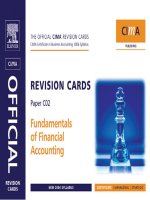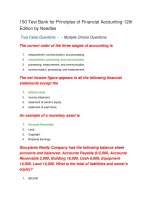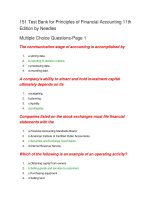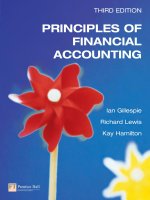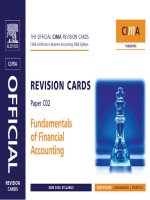Principles of financial accounting 12e by needles crosson chapter 13
Bạn đang xem bản rút gọn của tài liệu. Xem và tải ngay bản đầy đủ của tài liệu tại đây (360.68 KB, 27 trang )
C HAP TE R
13
Accounting for Corporations
Principles of
Accounting
12e
Needles
Powers
Crosson
©human/iStockphoto
Concepts Underlying the Corporate Form of
Business
A corporation is a separate entity chartered by
the state and legally separate from its owners, or
stockholders.
– Contributed capital refers to stockholders’
investments in a corporation.
A unit of ownership in a corporation is called a share
of stock.
– To form a corporation, most states require incorporators
to sign an application and file it with the proper state
official. This application contains the articles of
incorporation, which form the company charter.
The articles of incorporation state the maximum
number of shares that a corporation is authorized to
issue.
©2014 Cengage Learning. All Rights Reserved. May not be scanned, copied or duplicated, or posted to a publicly accessible website, in whole or in part.
Concepts Underlying the Corporate Form
of Business
– To invest in a corporation, a stockholder
transfers cash or other resources to the
corporation. In return, the stockholder
receives shares of stock representing a
proportionate share of ownership.
– Stockholders elect a board of directors,
which sets corporate policies and chooses
the corporation’s officers, who in turn carry
out the corporate policies in their
management of the business.
©2014 Cengage Learning. All Rights Reserved. May not be scanned, copied or duplicated, or posted to a publicly accessible website, in whole or in part.
Concepts Underlying the Corporate Form
of Business
– Besides deciding on major business policies, a
corporation’s board of directors:
authorizes contracts.
sets executive salaries.
arranges major loans with banks.
declares dividends, which are distributions, among
the stockholders, of the assets that a corporation’s
earnings have generated.
– Management of a corporation, which consists of
the operating officers, carries out corporate
policies, runs day-to-day operations, and
reports the financial results of its administration
to the board of directors and the stockholders.
©2014 Cengage Learning. All Rights Reserved. May not be scanned, copied or duplicated, or posted to a publicly accessible website, in whole or in part.
Advantages of Incorporation
Separate legal entity
Limited liability: Creditors can satisfy their claims only
against the assets of the corporation, not against the
personal property of the corporation’s owners.
Ease of capital generation
Ease of transfer of ownership
Lack of mutual agency: The corporation is not bound
by any contracts that individual stockholders may
enter into.
Continuous existence
Centralized authority and responsibility
Professional management
©2014 Cengage Learning. All Rights Reserved. May not be scanned, copied or duplicated, or posted to a publicly accessible website, in whole or in part.
Disadvantages of Incorporation
Government regulation: Corporations must file many
reports with the state in which they are chartered, and
publicly held corporations must also file reports with
the SEC and with their stock exchanges.
Double taxation: A corporation’s earnings are
subject to federal and state income taxes. If any of the
corporations’ earnings are paid out as dividends, the
earnings are taxed again as income to stockholders.
Limited liability: This may restrict the ability of a small
corporation to borrow money.
Separation of ownership and control: Management
may make decisions that are not good for the
corporation.
©2014 Cengage Learning. All Rights Reserved. May not be scanned, copied or duplicated, or posted to a publicly accessible website, in whole or in part.
Equity Financing
Equity financing is accomplished by issuing
stock to investors in exchange for assets.
– Once the stock has been issued to them,
stockholders can transfer their ownership at will.
Large corporations often appoint independent
registrars and transfer agents (usually banks and
trust companies) to help perform the transfer duties.
– Two important terms in equity financing are:
Par value—an arbitrary amount assigned to each
share of stock. It must be recorded in the capital stock
accounts.
Legal capital—the number of shares issued
multiplied by the par value. It is the minimum amount
that a corporation can report as contributed capital.
©2014 Cengage Learning. All Rights Reserved. May not be scanned, copied or duplicated, or posted to a publicly accessible website, in whole or in part.
Equity Financing
– To help with its initial public offering (IPO), a
corporation often uses an underwriter—an
intermediary between the corporation and the
investing public.
The corporation records the amount of the net
proceeds of the offering in its Capital Stock and
Additional Paid-in Capital accounts. The net proceeds
are what the public paid less the underwriter’s fees,
legal expenses, and other direct costs of the
offering.
The costs of forming a corporation are called startup and organization costs. These costs include
state incorporation fees, attorneys’ and accountants’
fees, the cost of printing stock certificates, and other
expenditures necessary to form the corporation.
©2014 Cengage Learning. All Rights Reserved. May not be scanned, copied or duplicated, or posted to a publicly accessible website, in whole or in part.
Advantages and Disadvantages of
Equity Financing
Advantages
– Decreased
financial risk
Issuing common
stock is less risky
than financing with
long-term debt.
– Increased cash for
operations
– Better debt to
equity ratio
Disadvantages
– Increased tax
liability
Whereas the interest
on debt is taxdeductible, the
dividends paid on
stock are not.
– Decreased
stockholder control
When a corporation
issues more stock, it
dilutes its
ownership.
©2014 Cengage Learning. All Rights Reserved. May not be scanned, copied or duplicated, or posted to a publicly accessible website, in whole or in part.
Components of Stockholders’ Equity
In a corporation’s balance sheet, the owners’
claims to the business are called stockholders’
equity.
– This section of a corporate balance sheet
usually has at least three components:
Contributed capital—the stockholders’ investments in
the corporation
Retained earnings—the earnings of the corporation
since its inception, less any losses, dividends, or
transfers to contributed capital. These are reinvested
in the business.
Treasury stock—shares of the corporation’s own stock
that it has bought back on the open market
©2014 Cengage Learning. All Rights Reserved. May not be scanned, copied or duplicated, or posted to a publicly accessible website, in whole or in part.
Types of Stock
A corporation can issue two types of stock:
– Common stock—the basic form of stock
Shares of common stock carry voting rights and usually
provide their owners with the means of controlling the
corporation.
Common stock is also called residual equity because the
claims of all creditors and usually those of preferred
stockholders rank ahead of the claims of common
stockholders.
– Preferred stock—stock that gives its owners
preference over common stockholders in terms of
receiving dividends and in terms of claims to
assets if the corporation is liquidated.
©2014 Cengage Learning. All Rights Reserved. May not be scanned, copied or duplicated, or posted to a publicly accessible website, in whole or in part.
Types of Shares
Authorized shares are the maximum
number of shares that a corporation’s charter
allows it to issue.
Issued shares are those that a corporation
sells or otherwise transfers to stockholders.
Outstanding shares are shares that a
corporation has issued and that are still in
circulation. A corporation may have more
shares issued than are currently outstanding if
it has bought back treasury shares.
©2014 Cengage Learning. All Rights Reserved. May not be scanned, copied or duplicated, or posted to a publicly accessible website, in whole or in part.
Preference as to Dividends
Preferred stockholders ordinarily must receive a
certain amount of dividends before common
stockholders receive anything.
– If the stock is noncumulative preferred stock and
the board of directors fails to declare a dividend in any
year, the company is under no obligation to make up
the missed dividend in future years.
– If the stock is cumulative preferred stock, the
dividend amount per share accumulates from year to
year if unpaid, and the company must pay the whole
amount before it pays any dividends on common stock.
Dividends not paid in the year they are due are called
dividends in arrears.
©2014 Cengage Learning. All Rights Reserved. May not be scanned, copied or duplicated, or posted to a publicly accessible website, in whole or in part.
Convertible and Callable Preferred Stock
(slide 1 of 2)
Owners of convertible preferred stock can
exchange their shares of preferred stock for
shares of common stock at a ratio stated in the
preferred stock contract.
– If the market value of the common stock
increases, the conversion feature allows these
stockholders to share in the increase by
converting their stock to common stock.
Most preferred stock is callable preferred stock
—that is, the issuing corporation can redeem it at
a price stated in the preferred stock contract.
©2014 Cengage Learning. All Rights Reserved. May not be scanned, copied or duplicated, or posted to a publicly accessible website, in whole or in part.
Convertible and Callable Preferred Stock
(slide 2 of 2)
– The call price, or redemption price, of callable
preferred stock is usually higher than the stock’s
par value.
– If the preferred stock is convertible, the
stockholder can either surrender the stock or
convert it to common stock.
– When preferred stock is called and surrendered,
the stockholder is entitled to:
The par value of the stock
The call premium
Any dividends in arrears
The current period’s dividend prorated by the proportion
of the year to the call date
©2014 Cengage Learning. All Rights Reserved. May not be scanned, copied or duplicated, or posted to a publicly accessible website, in whole or in part.
Issuance of Common Stock
A share of capital stock may be par or no-par.
– The value of par stock is stated in the corporate charter
and on each stock certificate.
A corporation cannot declare a dividend that would cause
stockholders’ equity to fall below the legal capital. Thus, par
value is a minimum cushion of capital that protects a
corporation’s creditors.
– No-par stock does not have a par value.
Most states require that all or part of the proceeds from a
corporation’s issuance of no-par stock be designated as legal
capital, which cannot be used unless the corporation is
liquidated.
State laws often require corporations to place a stated value
on each share of stock they issue. The stated value can be any
value set by the board unless the state specifies a minimum
amount, which is sometimes the case.
©2014 Cengage Learning. All Rights Reserved. May not be scanned, copied or duplicated, or posted to a publicly accessible website, in whole or in part.
Accounting for Treasury Stock
Treasury stock is stock that the issuing
company has reacquired, usually by
purchasing shares on the open market.
– A company may want to buy back its own stock
for any of the following reasons:
To distribute to employees through stock option plans.
To maintain a favorable market for its stock.
To increase its earnings per share or stock price per
share.
To have additional shares of stock available for
purchasing other companies.
To prevent a hostile takeover.
©2014 Cengage Learning. All Rights Reserved. May not be scanned, copied or duplicated, or posted to a publicly accessible website, in whole or in part.
Accounting for Cash Dividends
Although a corporation may have sufficient cash and
retained earnings to pay a dividend, its board of
directors may not do so for several reasons:
– The corporation may need the cash for expansion.
– It may want to improve its overall financial position by
liquidating debt.
– It may be facing major uncertainties, such as a pending
lawsuit, strike, or a projected decline in the economy.
If a corporation declares a dividend that exceeds
retained earnings, this is called a liquidating
dividend. A corporation usually pays a liquidating
dividend only when it is going out of business or
reducing its operations.
©2014 Cengage Learning. All Rights Reserved. May not be scanned, copied or duplicated, or posted to a publicly accessible website, in whole or in part.
Dividend Dates
Three important dates are associated with dividends:
- Declaration date—the date on which the board of directors
formally declares that the corporation is going to pay a
dividend
- Record date—the date on which ownership of stock is
determined
- Persons who own stock on the record date will receive the
dividend.
- Between the record date and the date of payment, the stock is
said to be ex-dividend.
- If the owner on the date of record sells the shares of stock
before the date of payment, the right to the dividend remains
with that person.
- Payment date—the date on which the dividend is paid to
the stockholders of record
©2014 Cengage Learning. All Rights Reserved. May not be scanned, copied or duplicated, or posted to a publicly accessible website, in whole or in part.
Stock Dividends
A stock dividend is a proportional distribution of
shares among a corporation’s stockholders.
– Unlike a cash dividend, a stock dividend involves no
distribution of assets.
– A board of directors may declare a stock dividend for the
following reasons:
To give stockholders some evidence of the company’s
success without affecting working capital.
To reduce the stock’s market price by increasing the number
of shares outstanding (a goal more often met by a stock
split).
To make a nontaxable distribution to stockholders.
To increase the company’s permanent capital by transferring
an amount from retained earnings to contributed capital.
©2014 Cengage Learning. All Rights Reserved. May not be scanned, copied or duplicated, or posted to a publicly accessible website, in whole or in part.
Stock Splits
A stock split occurs when a corporation
increases the number of shares of stock
issued and outstanding and reduces the
par or stated value proportionally.
– A company may plan a stock split for the
following reasons:
To lower its stock’s market price per share and,
thereby, increase the demand and volume of
trading for its stock at this lower price.
To signal to the market its success in achieving its
operating goals.
©2014 Cengage Learning. All Rights Reserved. May not be scanned, copied or duplicated, or posted to a publicly accessible website, in whole or in part.
Statement of Stockholders’ Equity
The statement of stockholders’ equity
summarizes changes in the components of the
stockholders’ equity section of the balance sheet.
©2014 Cengage Learning. All Rights Reserved. May not be scanned, copied or duplicated, or posted to a publicly accessible website, in whole or in part.
Book Value and Book Value per Share
The book value of stock represents a company’s total
assets less its liabilities (in other words, its net assets).
The book value per share is the equity of the owner
of one share of stock in the net assets of the company.
– If a company has only common stock outstanding, book
value per share is calculated as follows:
Stockholders’ equity ÷ Common Shares Outstanding =
Book Value per Share
– If a company has both preferred and common stock, the
preferred stock’s call value and any dividends in arrears
are subtracted from stockholders’ equity to determine the
equity pertaining to common stock.
©2014 Cengage Learning. All Rights Reserved. May not be scanned, copied or duplicated, or posted to a publicly accessible website, in whole or in part.
Dividend Yield
Dividend yield is computed by
dividing the dividends per share by the
market price per share.
– Investors use the dividend yield ratio to
evaluate the amount of dividends they
receive.
©2014 Cengage Learning. All Rights Reserved. May not be scanned, copied or duplicated, or posted to a publicly accessible website, in whole or in part.
Return on Equity
Return on equity is the ratio of net income
to average total stockholders’ equity.
– It is the most important ratio associated with
stockholders’ equity and is a common measure of
management’s performance.
– As a company sells more shares of stock,
– Management can reduce stockholders’ equity,
thereby increasing return on equity, by buying back
the company’s shares on the open market. The cost
of treasury stock has the following effect:
©2014 Cengage Learning. All Rights Reserved. May not be scanned, copied or duplicated, or posted to a publicly accessible website, in whole or in part.
